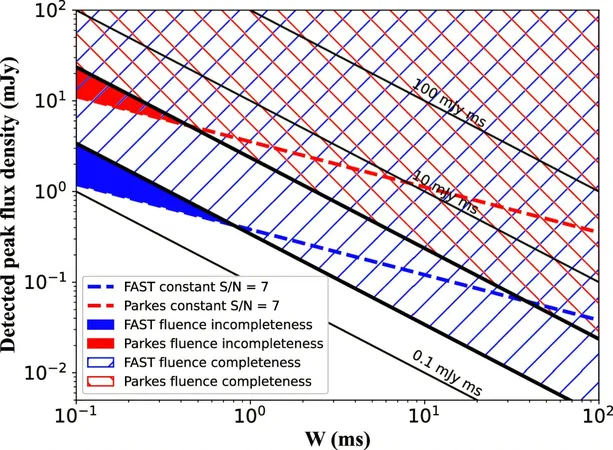
Mystery Deepens: Pulsing X-ray Sources Unlikely to Spawn Fast Radio Bursts
2025-06-17
Author: Daniel
Unlocking the Mysteries of Fast Radio Bursts
Fast radio bursts (FRBs) are among the most enigmatic phenomena in the universe. These powerful, millisecond-long radio pulses can unleash a staggering amount of energy, comparable to what our sun emits in an entire year. Despite their formidable presence, the true origins of these bursts have puzzled scientists for years.
New Research Challenges Current Theories
In a groundbreaking study, Dr. Bai Juntao and his team from the Xinjiang Astronomical Observatory have ventured into uncharted territory to explore the connections between fast radio bursts and pulsing ultraluminous X-ray sources (PULXs). Collaborating with experts from institutions like Guangzhou University and the Australian CSIRO, their thorough research has been published in The Astrophysical Journal.
What Are Pulsing Ultrawuminous X-ray Sources?
PULXs are extraordinary astrophysical entities, powered by neutron stars and emitting X-ray luminosities far surpassing the Eddington limit. This suggests that they engage in super-Eddington accretion processes that might, under certain models, create conditions ripe for FRBs.
The Search for FRB Signals
To investigate this tantalizing hypothesis, the research team conducted meticulous radio observations of eight PULXs using the Chinese Five-hundred-meter Aperture Spherical Telescope (FAST) and Australia's Parkes radio telescope. They scrutinized these celestial bodies across various orbital phases and utilized sophisticated techniques to detect any radio bursts across a range of dispersion measures.
A Surprising Result
However, in a striking turn of events, the team found no significant FRB-like radio signals emanating from any of the targeted sources. This finding points to the possibility that if FRB-like activity does occur in PULX systems, it may be exceedingly rare or obscured by factors such as powerful accretion-driven winds or complex magnetized environments.
Implications for Future Research
This pioneering investigation marks the first dedicated search for FRBs specifically within PULX systems, offering essential observational data to assess the potential for generating FRBs in binary systems. Additionally, it provides significant constraints on the increasingly popular "binary-origin" hypothesis for FRBs, thereby expanding the horizons of our quest to identify their true progenitors.



 Brasil (PT)
Brasil (PT)
 Canada (EN)
Canada (EN)
 Chile (ES)
Chile (ES)
 Česko (CS)
Česko (CS)
 대한민국 (KO)
대한민국 (KO)
 España (ES)
España (ES)
 France (FR)
France (FR)
 Hong Kong (EN)
Hong Kong (EN)
 Italia (IT)
Italia (IT)
 日本 (JA)
日本 (JA)
 Magyarország (HU)
Magyarország (HU)
 Norge (NO)
Norge (NO)
 Polska (PL)
Polska (PL)
 Schweiz (DE)
Schweiz (DE)
 Singapore (EN)
Singapore (EN)
 Sverige (SV)
Sverige (SV)
 Suomi (FI)
Suomi (FI)
 Türkiye (TR)
Türkiye (TR)
 الإمارات العربية المتحدة (AR)
الإمارات العربية المتحدة (AR)